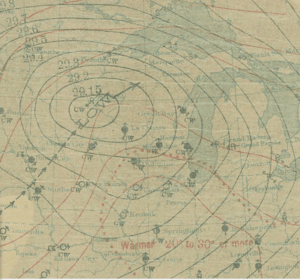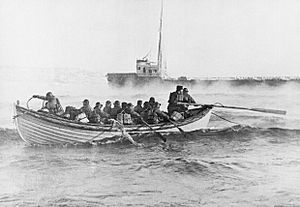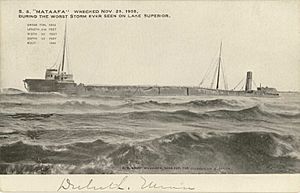Mataafa Storm facts for kids

Weather map of an extratropical cyclone approaching the Great Lakes on the morning of November 28, 1905
|
|
| Type | Extratropical cyclone |
|---|---|
| Formed | November 25, 1905 |
| Dissipated | November 29, 1905 |
| Lowest pressure | <991 mbar (hPa) |
| Damage | $3,567,000 |
| Areas affected | Plains, Great Lakes |
The Mataafa Storm of 1905 was a very powerful storm that hit the Great Lakes region on November 27 and 28, 1905. This storm caused a lot of damage and was named after the steamship Mataafa, which was badly damaged.
The storm destroyed or hurt about 29 ships. It also sadly caused the deaths of 36 sailors. The total cost of the damage to shipping was about US$3.567 million in 1905. This was a huge amount of money back then! Most of the damage happened on Lake Superior.
Contents
How the Storm Formed and What Happened
The storm system started moving across the Great Basin (a large dry region in the western United States) on November 26 and 27. Weather experts, then called the United States Weather Bureau, predicted strong easterly winds for the Great Lakes.
Storm Warnings and Strong Winds
By 6 p.m. on November 27, winds in Duluth, Minnesota, were blowing at 44 miles per hour (71 km/h). By the morning of November 28, storm warning flags were flying. This meant a serious storm was coming. The storm, which was a type of cyclone, moved into southern Minnesota.
Strong easterly winds and heavy snow spread across Lake Superior, Lake Huron, and Lake Erie. In Duluth, winds reached 68 miles per hour (109 km/h) early on November 28. The water level in Duluth Harbor also rose about 2.3 feet (0.7 meters) higher than normal. The storm brought heavy snow to the northern Great Lakes on November 28 and 29.
The Wreck of the SS Mataafa

The steamship SS Mataafa was a large ship that carried iron ore. On November 27, 1905, at 5 p.m., she was leaving Duluth with a smaller ship, the James Nasmyth, being towed behind her. The storm hit them hard.
Turning Back to Duluth
Even though the Mataafa tried to keep going, by 4 p.m. the next day, her captain, R. F. Humble, knew it was too dangerous. They were near Two Harbors, Minnesota. He decided to turn the ship around and head back to Duluth for safety.
As they got closer to Duluth, Captain Humble realized it would be impossible to get both the large steamer and the towed barge through the narrow Duluth Ship Canal. So, he ordered the James Nasmyth to be cut loose. The Mataafa then tried to enter the harbor alone.
Ship Breaks Apart
The Mataafa made it about halfway between the two concrete piers of the canal. Suddenly, a huge wave surged out from the harbor. This powerful water hit the ship's back, pushing its front end down into the muddy bottom. Then, the wave slammed the ship's back against the north pier.
The ship's rudder (which helps steer the ship) broke off. The water then pulled the front of the ship out towards the open lake, only to smash its back against the south pier. Finally, the Mataafa got stuck in the shallow water outside the north pier. There, the strong forces caused the ship to break into two pieces. The back part slowly sank into the water.
Rescue Efforts
When the ship broke, twelve men were in the back part. Three of them managed to struggle to the front part of the ship. Sadly, the remaining nine men in the back part died from the cold during the night. One of the bodies was found frozen in solid ice.
The fifteen men in the front part of the ship were luckier. Even though rescue attempts were difficult during the stormy night, a small boat finally reached them the next day. All fifteen men were safely taken off the ship in two trips.
Other Ships in the Storm
Many other ships were caught in the Mataafa Storm. Here are a few stories of what happened to them.
The Journey of the Joseph G. Butler, Jr.
The steamer Joseph G. Butler, Jr. (often called Butler) was on its way from the St. Clair River into Lake Huron on Sunday, November 26, 1905. The sky was gray and cloudy. The Butler steamed north all day.
On Monday morning, November 27, the Butler passed the Detour Reef Light and entered the Saint Marys River. That afternoon, the Butler went through the Soo Locks, just behind another steamer called the Bransford. The temperature was cold, about 28 degrees Fahrenheit (-2 degrees Celsius).
As the two ships crossed Whitefish Bay, the weather got much worse. The barometer (a tool that measures air pressure) dropped quickly, and the snow became very thick. By evening, the lookouts could barely see the light at Whitefish Point. The Bransford turned north to stay closer to the Canadian shore, hoping to avoid the worst of the storm. But the Butler turned southwest, taking a shorter path directly into the storm.
Fighting the Waves
As the Butler neared the Caribou Island Light, the ship's shaking changed. The constant pounding of waves was now mixed with violent shaking. Down in the engine room, the chief engineer knew this shaking meant the ship's propellers were coming out of the water. This happened when the ship was between huge waves, which were 10 to 20 feet (3 to 6.5 meters) high. The spinning blades would rise out of the water and then crash back down. This kind of pounding could break open the ship's seams.
The engineer had to stop the propellers every time they came out of the water and start them again once they were back in. If the ship lost its forward movement, it would be completely at the storm's mercy. But if the shaking wasn't stopped, the ship itself might break apart. The next challenge was Keweenaw Point, a piece of land sticking out into the lake. The ship's steward reported that the windows in the mess hall were broken, and there was 2 feet (61 cm) of water sloshing around inside.
All day on Tuesday, November 28, the Butler battled the wild seas. At one point, with no land in sight and fearing they might hit something, the Butler turned to run with the storm. They hoped this would help them clear any unseen shoreline.
Reaching Safety
Late that day, the storm began to calm down. When the captain could finally see across the lake again, he spotted the light at Outer Island in the Apostles. A new course was set for Duluth. The waves were still big, but the wind had lessened, and the snow had stopped. After about fifty hours since leaving Lorain, the Butler was finally on a steady path towards Duluth.
As the Butler passed Two Harbors, Minnesota, they saw the Bransford also heading for Duluth. Further ahead, they saw another steamer, the Perry G. Walker, which had left Duluth just two days earlier.
As the Butler got closer to Duluth, they saw more ships. The James Nasmyth (the barge that had been towed by the Mataafa) was anchored near Minnesota Point. It was sitting low in the water, loaded with iron ore and covered in a thick layer of ice. Then, the Butler saw the Mataafa itself, stuck in the shallow water near Minnesota Point and broken into several pieces. It was noon when the Butler finally steamed through the canal into St. Louis Bay. There, they saw the R. W. England beached on the other side of Minnesota Point, another victim of the strong winds.
Ships Damaged or Wrecked on November 28
Many ships were badly damaged or wrecked during the Mataafa Storm. Here is a list of some of them:
| Ship | Shipping Line | Location of Damage/Wreck | Damage |
|---|---|---|---|
| Isaac Ellwood (steamer) | Pittsburgh Steamship | Duluth | ran aground (stuck on the bottom) |
| Mataafa (steamer) | Pittsburgh Steamship | Duluth | ran aground and broke in two |
| R. W. England (steamer) | Tomlinson | Duluth | ran aground |
| Crescent City (steamer) | Pittsburgh Steamship | Lakewood (7 miles NE of Duluth) | ran aground against cliffs |
| Lafayette (steamer) | Pittsburgh Steamship | Encampment Island (7 miles NE of Two Harbors, Minnesota) | broke apart |
| Manila (barge of Lafayette) | Pittsburgh Steamship | Encampment Island (7 miles NE of Two Harbors) | ran aground |
| William Edenborn (steamer) | Pittsburgh Steamship | near Split Rock River | stuck hard ashore and broke in two |
| Madeira (barge of Edenborn) | Pittsburgh Steamship | Gold Rock (3 miles NE) | sank and broke in two |
| George Herbert (scow) | Two Island, near Schroeder, Minnesota | smashed to pieces | |
| George Spencer (wooden steamer) | Thomasville (near Tofte, Minnesota) | stuck hard aground | |
| Amboy (barge of Spencer) | stuck hard aground | ||
| Monkshaven (steamer) | Pie Island, Port Arthur, Ontario | stuck on the rocks | |
| William E. Corey (steamer) | Pittsburgh Steamship | Gull Island (Apostles) | stranded (stuck) |
| Western Star (steamer) | Fourteen-Mile Point near Ontonagon, Michigan | stuck very tight | |
| Coralia (steamer) | Pittsburgh Steamship | Point Isabelle (east side Keweenaw Peninsula) | stuck |
| Maia (barge of Coralia) | Pittsburgh Steamship | Point Isabelle (east side Keweenaw Peninsula) | stuck |
| Ira H. Owen (steamer) | National Steamship | NE of Outer Island (Apostles) | sank |
| Perry G. Walker (steamer) | Two Harbors | badly damaged deck house | |
| Vega (steamer) | Gilchrist Transportation Co. | South or North? side of Fox Island | broke in two and was destroyed |
| J.H. Outhwaite (wooden steamer) | W.C. Richardson | Straits of Mackinac | driven ashore and burned down |
What Happened After the Storm?
The Mataafa Storm showed how dangerous the Great Lakes could be. Because of this storm, the famous Split Rock Lighthouse was built on Lake Superior, near Silver Bay, Minnesota. This lighthouse was built to help guide ships and prevent future disasters.
The storm also led to an important legal case called Vincent v. Erie. This case is still studied in law schools today!
Images for kids




